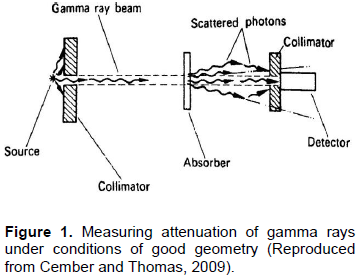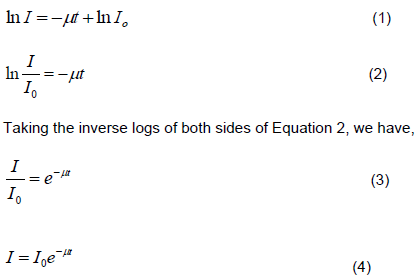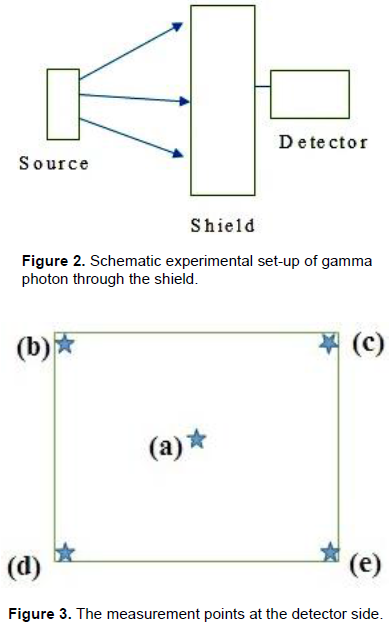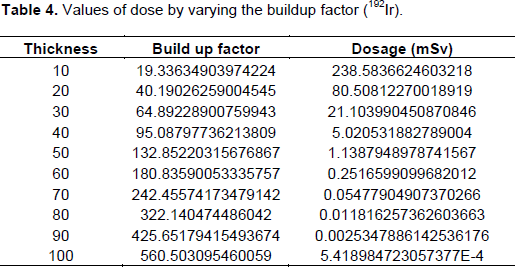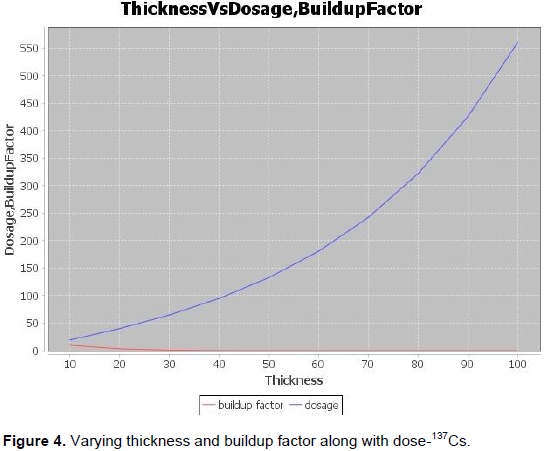ABSTRACT
The intensity of the ionizing radiations can be reduced by allowing them to pass through certain materials and such external materials are known as shields. The shielding material is often chosen based on the type and intensity of the radiation. The radionuclides of standard radioactive sources for calibration purpose or therapeutic use, the irradiated components that produce ionizing radiation of high intensity shall be attenuated by choosing relevant materials like mild steel, stainless steel, lead, or low ‘z’ materials in case of beta emission etc., So whatever be the shielding material, the thickness of the material holds a pivotal role in reduction of dose. Concrete is used as a more common building material in order to have an in situ protection rather than the material design and shielding. A software tool is developed (J-shielder) to find out the thickness of the shielding material to achieve the desired attenuation. The paper reveals that the numerical simulations performed to find out the attenuation of gamma rays while passing through ordinary concrete using the software. The execution of this application software is found useful in determining at the shield thickness of ordinary concrete for radionuclides of different strength and energies.
Key words: Ionizing radiation, shielding, attenuation, numerical simulation.
The effect of ionizing radiations such as alpha, beta, gamma and X-ray photons were enormously studied as they cannot be felt by any of our sense organs. Amongst all these, though the linear energy transfer is low, the penetrating effect of gamma radiation demands for the protection against external exposure to individuals (Cember and Thomas, 2009). The industries such as nuclear power reactors, fuel cycle facilities, accelerator units, medicine, research and development etc., involve handling of frequent use of radioactive materials which will emit ionizing radiations. Apart from radiological protection measures during handling of radioactive elements, the in-situ protection of untoward exposure is reduced by the shielding material provided to encompass the radioactive source or by the building material used to store the radioactive material. Other than specific irradiated components, the facilities may also use radionuclides of higher strength ( of the order of Curie) as standard calibration sources (Matthias and Sha, 2004).
The industries handling radioactive sources require following the exposure reduction practices to avoid the undue radiological hazards to the workers, public and the environment (Matthias and Sha, 2004). The radiological safety officer (health physicist) of the facility will be responsible for carrying out the activities in consultation with the facility management. The radioactive sources find its applications in medicine, research and development, non-destructive evaluation, mining and milling, operation of nuclear power plants etc., and the radiation protection practices are strictly adhered to in all these facilities. The regulators of every country monitor the facilities for the control on exposure from ionizing radiation. The dose limits are fixed to avoid any untoward risk from exposure to ionising radiation.
The process of radiation protection of such industries begins from the design level. It is equally as important as selection of materials for sophisticated components that would come in direct contact with the high active sources, like fission products, activation products and the corrosion products. The materials for components are chosen based on the physical, chemical and other related properties. The building materials are also chosen with care that they should withstand with the effects of ionizing radiation. While choosing the building material, it is taken care that they do not only withstand with the effects of ionizing radiation but also to provide some attenuation to the peripheral of the facility. The ordinary concrete is the material of fitting choice as the properties are widely discussed and experienced (Dunstel et al., 1971). Besides ordinary concrete, there are different types of concrete available, such as Magnetite concrete, Barytes concrete, Ferrophosphorus concrete etc. The experiment is carried out with ordinary concrete as its properties widely studied and applied in most of the facilities with two different radionuclides of different strength and energies. The dose was measured using survey meters and the values were calculated by substituting the relevant values in the attenuation relation (Ray, 2005). The dose rate was calculated with varying thickness and buildup factor using simulation.
When gamma radiation passes through matter its intensity decreases due to the interactions of gamma ray with them such as photo electric effect, Compton Effect, pair production and photonuclear reactions (Jahan et al., 2004). The materials which are used to attenuate the gamma are the shields. The gamma ray cannot be completely absorbed by the shielding material but the intensity can be comparatively reduced. The attenuation by the shielding material depends upon the energy of the incident radiation and the thickness of the shielding applied. The principle of radiation protection states that the optimization of protection needs to be given due care. Though the key task of employing shielding material is to provide attenuation, the cost of implementing it on the field is to be optimized. The optimization of the shielding material could be done based on the occupancy rate of the workers at the specific location. If the occupancy is limited and only the restricted entry is permitted, the shielding material may accordingly be chosen to attain the required dose rate. The selection of shielding material, cost of manufacturing of the shield with required thickness, the time frame for the manufacture etc., play a role in optimization of cost of a shielding material. The thickness of the shielding material would have its impact on cost (Dunstel et al., 1971).
The various types of concrete materials and their attenuation factors were reported in the earlier studies (Akkurt et al., 2006; Chilton, 1967; Dunstel et al., 1971; Hubbell and Seltzer, 2004; Jahan et al., 2004; Stankovic et al., 2009). The present investigation was carried out with two different energies 0.36 MeV (Iridium – 192Ir) and 0.662 MeV (Caesium-137Cs) with ordinary concrete as shielding material. The obtained results were compared with the simulation results (Akkurt et al., 2006; Chilton, 1967; Dunstel et al., 1971; Hubbell and Seltzer, 2004; Jahan et al., 2004; Stankovic et al., 2009).
A software tool, J-Shielder is developed that will run the attenuation relation for various thicknesses of the shielding material. The dose rate is calculated for desired number of values by iterative approach. This gives out the precise view of the thickness of the shielding material to be chosen with the corresponding dose rate experienced after attenuation.
Exponential absorption
The attenuation of gamma radiation (photons) by an absorber is qualitatively different from that of either alpha or beta radiation. The alpha and beta radiations defined ranges in matter and therefore, they can be stopped. The range of gamma radiation is high compared with the alpha and beta radiation, its intensity can only be reduced and it cannot be absorbed completely. The attenuation of the gamma radiation is calculated under the conditions of defined geometry. The narrow collimated beam of gamma radiation is shown in Figure 1 (Cember and Thomas, 2009).
Where
I0 is the gamma-ray intensity at zero absorber thickness,
t is the absorber thickness,
I is the gamma-ray intensity transmitted through an absorber of thickness t,
e is the base of the natural logarithm system, and
μ is the slope of the absorption curve = the attenuation coefficient.
Under conditions of good geometry, the attenuation of a beam of gamma radiation is given by . The arrangement of a good geometry with a collimated set-up of the source is shown in Figure 1. The details shown on the figure are indicative only. If the source is not collimated and the beam of radiation is left free to reach the absorber, then the attenuation calculated by the above Equation 1 will be an underestimated value. The effect of re-scattering of the photon has to be taken into account to find out the exact attenuation.
In designing a shield against a broad beam of radiation, the required attenuation may be estimated by modification of Equation 4 through the use of a buildup factor B:
Where B is the buildup factor. It is defined as the ratio of the intensity of the radiation, including both the primary and scattered radiation at any point in a beam to the intensity of the primary radiation only at that point. It may apply either to radiation flux to radiation flux or to radiation dose. The buildup factor has the value greater than 1.
Though the Linear Energy Transfer (LET) of the gamma radiation is less, its penetrating power through matter becomes significant in depositing energy to the absorbing material (Kirn et al., 1954).
Linear Energy Transfer (LET) is related to specific ionization when attention is focused on the energy lost by the radiation. Energy loss of the radiation corresponds to the medium of absorption. The rate of energy absorption is referred by LET. It is defined as the ratio of average energy locally transferred to the absorbing medium by a charged particle of specified energy in traversing a distance of dl. LET is usually expressed in terms of kilo electron volts per micron (keV/ μm).
LET = dEL/dL (6)
The interaction of gamma with low energy radionuclides causes photoelectric effect and Compton effect. In both the cases, it deposits the energy to the interacting electron. The ordinary concrete is taken as the shielding material of study. Initially, the gamma photon of energy 0.662 MeV was employed to pass through the shield and the values were measured. The buildup factor was calculated using the Equation 4.
Gamma photon source
A gamma photon of energy 0.662 MeV (Caesium - 137Cs) of 1 Ci (Curie) was placed at 1 m away from the shielding material. The source is assumed to be a point source for the purpose of measurement. The dose rate calculated at 1m distance from the 137Cs source is 3.56 mSv/h (3.56 mR/h). The shield is placed at 1 m distance from the detector. The dose rate after attenuation is calculated using the Equation 5. Another gamma photon of energy 0.36 MeV (Iridium 192Ir) was also used to obtain results. The calculated dose rate at 1 m distance from the source is 76 mSv/h (7.6 R/h), that is, before placing to the shield. After shield dose rate was calculated by the Equation 1. The radiation dose at the other end of the shielding was measured using a survey meter that uses a GM tube as detector for both the cases of measurement.
Shielding material
The ordinary concrete is chosen as it is a common source of building material. The schematic diagram showing the experimental arrangement of the source, detector and measurement are shown in Figure 2. The points of measurement on the other side of the shielding material are depicted in Figure 3.
The parameters of the ordinary concrete used in the present study are as follows:
Shielding material : Ordinary concrete
Density : 2.35 g/cm3
Linear attenuation co-efficient (1/cm) : 0.181801
Mass attenuation co-efficient (cm2/g) : 0.77362
Shield thickness (cm) : 50
The center point indicates the detector portion touching the shielding material. The corner points indicate the 1m distance away from the center of the detector portion.
Simulations using iterative approach method
The numerical simulation was made to measure through the distances from the source to the shield. The transmissions at the detector end were arrived by generating random numbers for the solution. The operation system used was Windows 7 and the software J-shielder was developed.
Theory of J-Shielder
The software employs the Taylor’s notation for buildup factors and the values of variables a1 and a2 were used from the available literature (Matthias and Sha, 2004).
Required software setup for J Shielder to function or work
The software J Shielder works in Java 7 or most recent version and in Windows 7 or most recent version. It has a PDF viewer to view the output file. For execution of the software, the class path needs to be set. While installing Java, it will be configured automatically and if not it can be set during execution.
Principle of working of the software
The software needs to be configured first and the initial values need to be fed for running the same for getting the output. The stepwise procedure of the working of the software is discussed below.
1) Once the software is placed inside a directory along with the configure properties, the software is in ready state.
2) The software assumes the thickness starts from 10 cm and increments by 10 and interpolates to 100.
3) The values mentioned in the configure property can be changed as per the need. There is no restriction in that.
4) The buildup factor mentioned in the configure property is default value for the thickness 10cm. So ensure that default build up factor is provided only for that.
5) To calculate dosage value with varying thickness for mentioned values in property file, software reads the values given in property and assigns to itself locally.
6) Software iterates the thickness with incremental approach and fetches dose at each increment. The different doses obtained will be stored in a list and a table is generated in PDF. The same list will be used to create graph.
7) To calculate varying buildup factor with varying thickness and calculate dose with obtained buildup factor. The software reads the input from property file.
8) First it calculates the buildup factor for each varying thickness, then at each varying thickness and respective buildup factor the dose will be calculated.
9) Both the buildup factor and dose is stored in list. Graph and PDF will be created with the list.
10) Software exists once the output files are generated.
11) Software can be used n number of times, to repeat and obtain outputs for desired values.
The simulation was done by varying the buildup factors corresponding to the thickness of the shield. The dose rate was calculated by keeping the buildup factor and varying the thickness. This was done to observe the change in dose rates. A graph was plotted between the thickness and the build -up factors to understand the variation in dose rates in each case. The results of the dose rate by passing through the thickness of 50 cm ordinary concrete was analyzed and compared with the experimental, calculated and simulated value. The degree of accuracy in each case was taken as a reference to confirm the accuracy of the simulated value.
With respect to the experimental set-up mentioned in Figures 1 and 2 above, the values observed for gamma photon of energy 0.662 MeV (Caesium-137) and 0.36 MeV (Iridium-192) were tabulated with the thickness of 50 cm of ordinary concrete. As the strength of both the radionuclides is high, the thickness is considered as 50 cm for the experiment in order to get the dose value in the order of micro Sievert. The calculated value was obtained using the Equation 1. The experimental values are obtained by using the radiation survey meter. The observed values and the calculated values using the attenuation equation for 137Cs are shown in Table 1 and for 192Ir in Table 2.

From Tables 1 and 2, the values at b, d and c, e are relatively different from the value a. The value at ‘a’ is the point of measurement precisely at the other side of the source. The locations b, d and c, e are the points of measurements at 1m on the other side of the measurement. The scattering distance from the source is observed as the diagonal position for these points of measurements. Despite, the distance, the positioning of the source facing direction is towards the right hand side that is, facing towards c and e points. The relative increase or decrease is observed through the survey meter at these angles. However, the ratio of deviation is found negligible in both the cases. From the Tables 1 and 2, it is clearly indicated that the measured value is in very good agreement with the calculated value.
The values obtained by simulation of varying thickness and the buildup factor for ordinary concrete was studied for the attenuation granted for radiation protection. These values were tabulated for both 137Cs and 192Ir in Tables 3 and 4 respectively. The iteration of the input data fed is simulated using the attenuation equation given in Equation 5.
A graph was plotted for the varying thickness and the buildup factor to arrive the values of dose as shown in Figure 4. The values were simulated for thickness of the ordinary concrete ranging from 10 cm to 100 cm. The dose value obtained for thickness of 50 cm exactly matches with the calculated value and the observed value with closer proximity. The graph below depicts the relation of thickness and build up actor for 137Cs.
From Figure 4, it is seen that as the thickness increases the corresponding buildup factor and the dose value decreases. Figure 5 depicts the response of thickness and buildup factor for 137Cs.
From the above Figures 4 and 5 and Tables 1 and 3, the measured, calculated and simulated values for the thickness of 50 cm of ordinary concrete, the obtained dose values are in good agreement with the simulated values which is indicated in the simulation Table 3. Similarly it was verified from Tables 2 and 4 that the obtained dose values are in good agreement with the simulated values as indicated in the simulation Table 4.
Similarly, the values of thickness and varying build up factors were simulated for 192Ir were also plotted. As the closer proximity of the true value of 137Cs was estimated, the same value was obtained for simulated of Iridium -192.
Figure 6 shows the relation between the varying thickness and the buildup factor to arrive the values of dose. The values were simulated from 10 to 100 cm thickness of the ordinary concrete. The dose value obtained for thickness of 50 cm exactly matches with the calculated value and the observed value with closer proximity for the measured values of Iridium-192.
The above mentioned Figure 5 shows the relation between the thickness and the buildup factor in case of the shielding material and in this experiment, ordinary concrete when the Iridium-192 source is used. The study is aimed to correlate the results through the observed value, calculated value and the simulated value. The calculated and simulated values were compared with experimental values. The experiment was done with 50 cm thickness of ordinary concrete. The closer proximity of the values in all three methods show the consistency of the software developed.
The paper has demonstrated the numerical simulations on the transmission of gamma rays through ordinary concrete to investigate the attenuation rendered by the shield. First, the attenuation of gamma ray of energy 0.662 MeV (Caesium-137) by ordinary concrete is employed and the results were compared. The study of 0.36 MeV (Iridium-192) was also carried out for preciseness. The calculated dose value of 137Cs after passing through the shield is 53 mSv and the measured value is 50 mSv. The value obtained in simulation using the J-shielder is 53 mSv. The calculated value is numerically higher than the observed value. The shielding thickness is decided based on the calculated value. For radiation protection practices, it is safer to fix the higher values of thickness of the shields. This applies well with the self-developed J-Shielder software. The closer proximity obtained through the study has indicated that this numerical simulation may be employed to pursue further futuristic calculations on the attenuation of different energies and in more particular, helpful in cases where there is no analogous experimental data exist like irradiated components, etc.
The authors have not declared any conflict of interests.
REFERENCES
|
Akkurt CB, Kilincarsdan S, Mavi B, Akkurt A (2006). Radiation shielding of concretes containing different aggregates. Cem. Concr. Compos. 28(2):153-157.
Crossref
|
|
|
|
Chilton AB (1967). Build up factors for point isotropic gamma ray sources in infinite medium of ordinary concrete, Nucl. Eng. Design 6(3):205-212.
Crossref
|
|
|
|
|
Cember H, Thomas EJ (2009). Introduction to Health Physics (Fourth Edition) (Chapter 5,10). McGraw Hill Publishers, NewYork
|
|
|
|
|
Dunstel HJ, Ellis RE, Jones BE, Jones EW, Rees IM, (1971). Handbook of radiological protection-Part I, Data, Radioactive substances advisory committee, HMSO, London.
|
|
|
|
|
Hubbell JH, Seltzer SM (2004). Tables of X-ray mass attenuation coefficients and mass-energy absorption co-efficients (Version1.4), National Institute of Standards and Technology, Gaithersburg, Md., USA.
|
|
|
|
|
Jahan Z, Waheed A, Orfi SD (2004). Radiation dose reduction by different types of concrete shields (C-Shielder manual), Health Physics Division, Pakistan Institute of Nuclear Science & Technology, P.O. Nilore, Islamabad, Pakistan. December 2004.
|
|
|
|
|
Kirn FS, RJ Kennedy, HO Wyckoff (1954). The attenuation of gamma rays at oblique incidence, Radiol 63(1):94-104.
Crossref
|
|
|
|
|
Matthias P, Sha L (2004) Properties of radioactive materials and methods of measurement, protocol for the laboratory work, 28th January 2004.
|
|
|
|
|
Ray M (2005) Shielding and build-up factors explained, MIT, Rad Pro Calculator, Software Development.
|
|
|
|
|
Stankovic SJ, Ilic RD, Jankovic K, Bojovic D, Loncar B (2009). Gamma radiation absorption characteristics of concrete with components of different type materials, presented at the 11th Annual Conference of the materials research society of Serbia, YUCOMAT 2009.
|
|
